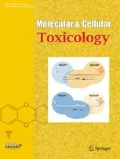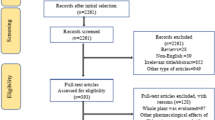Abstract
Background
Sorafenib (SOR) is the only approved molecular targeted agent for the treatment of hepatocellular carcinoma (HCC), however, its use is delayed by the recently articulated safety concerns.
Objective
The present study aimed to test the hypothesis that combining snake venoms (SVs) or its ingredient l-amino acid oxidase (LAAO) could synergistically enhance the anti-proliferative effects of SOR at low doses on liver cancer cells (HepG2) versus normal liver cells (THLE2).
Methods
The cytotoxic effects were measured on HepG2 and THLE-2 using MTT assay. Gene expression for apoptotic, inflammatory, antioxidant and cell cycle regulator genes was detected by real-time PCR. The number of cells in each cell cycle phase was determined by flow cytometry.
Results
SV, LAAO, and SOR exhibited higher cytotoxicity on HepG2 cells than THLE2 cells with the 2 combinations (2 LAAO + 3/4 SOR and 3 LAAO + 3/4 SOR) showed a potent synergistic anti-tumor effect on HepG2 while being safer on THLE-2. These 2 combinations significantly elevated the expression of apoptotic (Bax, caspase 3, 8, 9, p21), inflammatory (IL6, IL1β), and antioxidant (Nrf2 and HO-1) genes, and significantly decreased the expression of the anti-apoptotic Bcl2 and DNA topoisomerase 2-binding protein 1 (Topbp1) genes relative to the single treatment. Besides, there were a significant increase in MDA and SOD but a significant decrease in GPx and CAT activity in combined and single treatments with SOR versus the untreated control. The combined therapy also arrested HepG2 in the G2/M phase.
Conclusion
Our results suggest a novel synergistic, selective, inflammatory, and anti-proliferative effect of SV or LAAO with SOR on HepG2 cells. These 2 novel combinations could serve as a potential tool for the development of a novel therapeutic approach against HCC.





Similar content being viewed by others
References
Abdelkafi-Koubaa Z, Aissa I, Morjen M, Kharrat N, El Ayeb M, Gargouri Y, Srairi-Abid N, Marrakchi N (2016) Interaction of a snake venom L-amino acid oxidase with different cell types membrane. Int J Biol Macromol 82:757–764
Al-Bitar S, Gali-Muhtasib H (2019) The role of the cyclin dependent kinase inhibitor p21(cip1/waf1) in targeting cancer: molecular mechanisms and novel therapeutics. Cancers 2019:11
Ande SR, Kommoju PR, Draxl S, Murkovic M, Macheroux P, Ghisla S, Ferrando-May E (2006) Mechanisms of cell death induction by L-amino acid oxidase, a major component of ophidian venom. Apoptosis Int J Program Cell Death 11:1439–1451
Awad MG, Ali RA, Abd El-Monem DD, El-Magd MA (2020) Graviola leaves extract enhances the anticancer effect of cisplatin on various cancer cell lines. Mol Cell Toxicol. 16:385–399. https://doi.org/10.1007/s13273-020-00092-8
Boudou-Rouquette P, Narjoz C, Golmard JL, Thomas-Schoemann A, Mir O, Taieb F, Durand JP, Coriat R, Dauphin A, Vidal M, Tod M, Loriot MA, Goldwasser F, Blanchet B (2012) Early sorafenib-induced toxicity is associated with drug exposure and UGTIA9 genetic polymorphism in patients with solid tumors: a preliminary study. PLoS ONE 7:e42875
Burin SM, Berzoti-Coelho MG, Cominal JG, Ambrosio L, Torqueti MR, Sampaio SV, de Castro FA (2016) The L-amino acid oxidase from Calloselasma rhodostoma snake venom modulates apoptomiRs expression in Bcr-Abl-positive cell lines. Toxicon 120:9–14
Chiou JF, Tai CJ, Wang YH, Liu TZ, Jen YM, Shiau CY (2009) Sorafenib induces preferential apoptotic killing of a drug- and radio-resistant Hep G2 cells through a mitochondria-dependent oxidative stress mechanism. Cancer Biol Ther 8:1904–1913
Chou T-C (2010) Drug combination studies and their synergy quantification using the Chou-Talalay method. Can Res 70:440–446
Costa A, Scholer-Dahirel A, Mechta-Grigoriou F (2014) The role of reactive oxygen species and metabolism on cancer cells and their microenvironment. Semin Cancer Biol 25:23–32
Costa TR, Menaldo DL, Zoccal KF, Burin SM, Aissa AF, Castro FA, Faccioli LH, Greggi Antunes LM, Sampaio SV (2017) CR-LAAO, an L-amino acid oxidase from Calloselasma rhodostoma venom, as a potential tool for developing novel immunotherapeutic strategies against cancer. Sci Rep 7:42673
de Melo Alves Paiva R, de Freitas Figueiredo R, Antonucci GA, Paiva HH, de Lourdes Pires Bianchi M, Rodrigues KC, Lucarini R, Caetano RC, Linhari Rodrigues Pietro RC, Martins CH, de Albuquerque S, Sampaio SV (2011) Cell cycle arrest evidence, parasiticidal and bactericidal properties induced by L-amino acid oxidase from Bothrops atrox snake venom. Biochimie 93:941–947
Elghazaly H, Gaballah A, Eldin NB (2018) Clinic-pathological pattern of hepatocellular carcinoma (HCC) in Egypt. Ann Oncol 29:v5–v6
El-Magd MA, Mohamed Y, El-Shetry ES, Elsayed SA, Abo-Gazia M, Abdel-Aleem GA, Shafik NM, Abdo WS, El-Desouki NI, Basyony MA (2019) Melatonin maximizes the therapeutic potential of non-preconditioned MSCs in a DEN-induced rat model of HCC. Biomed Pharmacother 114:108732
Forrester SJ, Kikuchi DS, Hernandes MS, Xu Q, Griendling KK (2018) Reactive oxygen species in metabolic and inflammatory signaling. Circ Res 122:877–902
Furfaro AL, Traverso N, Domenicotti C, Piras S, Moretta L, Marinari UM, Pronzato MA, Nitti M (2016) The Nrf2/HO-1 axis in cancer cell growth and chemoresistance. Oxid Med Cell Longev 2016:1958174
Gao J, Xie L, Yang WS, Zhang W, Gao S, Wang J, Xiang YB (2012) Risk factors of hepatocellular carcinoma–current status and perspectives. Asian Pac J Cancer Prevent 13:743–752
Gomes A, Choudhury SR, Saha A, Mishra R, Giri B, Biswas AK, Debnath A, Gomes A (2007) A heat stable protein toxin (drCT-I) from the Indian Viper (Daboia russelli russelli) venom having antiproliferative, cytotoxic and apoptotic activities. Toxicon 49:46–56
Guo C, Liu S, Dong P, Zhao D, Wang C, Tao Z, Sun MZ (2015) Akbu-LAAO exhibits potent anti-tumor activity to HepG2 cells partially through produced H2O2 via TGF-β signal pathway. Sci Rep 5:18215
Kashyap D, Tuli HS, Yerer MB, Sharma A, Sak K, Srivastava S, Pandey A, Garg VK, Sethi G, Bishayee A (2021) Natural product-based nanoformulations for cancer therapy: opportunities and challenges. Semin Cancer Biol 69:5–23
Khamis AAA, Ali EMM, El-Moneim MAA, Abd-Alhaseeb MM, El-Magd MA, Salim EI (2018) Hesperidin, piperine and bee venom synergistically potentiate the anticancer effect of tamoxifen against breast cancer cells. Biomed Pharmacother 105:1335–1343
Kim KH, Rodriguez AM, Carrico PM, Melendez JA (2001) Potential mechanisms for the inhibition of tumor cell growth by manganese superoxide dismutase. Antioxid Redox Signal 3:361–373
Lee ML, Fung SY, Chung I, Pailoor J, Cheah SH, Tan NH (2014) King cobra (Ophiophagus hannah) venom L-amino acid oxidase induces apoptosis in PC-3 cells and suppresses PC-3 solid tumor growth in a tumor xenograft mouse model. Int J Med Sci 11:593–601
Lezaja A, Altmeyer M (2018) Inherited DNA lesions determine G1 duration in the next cell cycle. Cell Cycle (georgetown, Tex) 17:24–32
Magdy A, Sadaka E, Hanafy N, El-Magd MA, Allahloubi N, El Kemary M (2020) Green tea ameliorates the side effects of the silver nanoparticles treatment of Ehrlich ascites tumor in mice. Mol Cell Toxicol 16:271–282
Ramos OHP, Selistre-de-Araujo HS (2006) Snake venom metalloproteases–structure and function of catalytic and disintegrin domains. Comparative biochemistry and physiology. Toxicol Pharmacol 142:328–346
Shaban AM, Hammouda O, Abou Ghazala L, Raslan M, El-Magd MA (2018) Ethyl acetate fraction of garlic (Allium sativum) inhibits the viability of MCF7 and HepG2 through induction of apoptosis and G2/M phase cell cycle arrest. J Appl Pharm Sci 8:142–150
Siegel AB, Zhu AX (2009) Metabolic syndrome and hepatocellular carcinoma: two growing epidemics with a potential link. Cancer 115:5651–5661
Tan KK, Bay BH, Gopalakrishnakone P (2018) L-amino acid oxidase from snake venom and its anticancer potential. Toxicon 144:7–13
Ullah A (2020) Structure-function studies and mechanism of action of snake venom L-amino acid oxidases. Front Pharmacol 11:110–110
Vyas VK, Brahmbhatt K, Bhatt H, Parmar U (2013) Therapeutic potential of snake venom in cancer therapy: current perspectives. Asian Pac J Trop Biomed 3:156–162
Wardman P (2001) Electron transfer and oxidative stress as key factors in the design of drugs selectively active in hypoxia. Curr Med Chem 8:739–761
Warner RL, McClintock SD, Barron AG, de la Iglesia FA (2009) Hemostatic properties of a venomic protein in rat organ trauma. Exp Mol Pathol 87:204–211
Zhang L, Wu WT (2008) Isolation and characterization of ACTX-6: a cytotoxic L-amino acid oxidase from Agkistrodon acutus snake venom. Nat Prod Res 22:554–563
Zhang HJ, Zhao W, Venkataraman S, Robbins ME, Buettner GR, Kregel KC, Oberley LW (2002) Activation of matrix metalloproteinase-2 by overexpression of manganese superoxide dismutase in human breast cancer MCF-7 cells involves reactive oxygen species. J Biol Chem 277:20919–20926
Zhang H, Teng M, Niu L, Wang Y, Wang Y, Liu Q, Huang Q, Hao Q, Dong Y, Liu P (2004) Purification, partial characterization, crystallization and structural determination of AHP-LAAO, a novel L-amino-acid oxidase with cell apoptosis-inducing activity from Agkistrodon halys pallas venom. Acta Crystallogr Sect d Biol Crystallogr 60:974–977
Acknowledgements
This study was funded by authors and no other fund was received.
Author information
Authors and Affiliations
Contributions
EE, AA, and IA designed the experiments; DM, ME, and GM conducted the experiments; EE, ME, and DM analyzed the data; EE, DM and ME wrote the manuscript; and all authors revised the manuscript.
Corresponding authors
Ethics declarations
Conflict of interest
DM declares that she has no conflict of interest. ME declares that he has no conflict of interest. GM declares that she has no conflict of interest. AA declares that he has no conflict of interest. IA declares that he has no conflict of interest. EE declares that he has no conflict of interest.
Ethical approval
Approval of the present study was obtained by the Ethics Committee of Cairo University.
Additional information
Publisher's Note
Springer Nature remains neutral with regard to jurisdictional claims in published maps and institutional affiliations.
Rights and permissions
About this article
Cite this article
Mahfouz, D.H., El-Magd, M.A., Mansour, G.H. et al. Therapeutic potential of snake venom, l-amino oxidase and sorafenib in hepatocellular carcinoma. Mol. Cell. Toxicol. (2021). https://doi.org/10.1007/s13273-021-00151-8
Accepted:
Published:
DOI: https://doi.org/10.1007/s13273-021-00151-8




